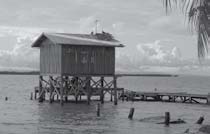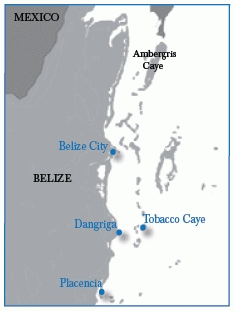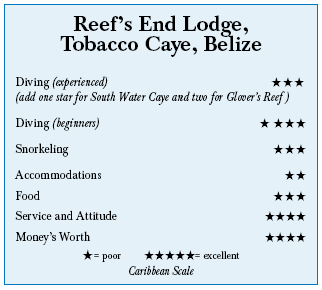Reef’s End Lodge, Tobacco Caye, BelizeContents of this Issue: Reef’s End Lodge, Tobacco Caye, Belize Malapascua and Panglao, Philippines More Philippine Dive Resort Picks Freak Wave Capsizes Shark Boat, Kills Three Divers The Art of Underwater Photography Editorial Office: Ben Davison Publisher and Editor Undercurrent 3020 Bridgeway, Suite 102 Sausalito, CA 94965 rustic and remote, but better diving than up north from the May, 2008 issue of Undercurrent
Dear Fellow Diver: Years ago, my favorite Belizean diving was at Ambergris Caye. But no more. As we reported in the February issue of Undercurrent, San Pedro has gone upscale -- herbal wraps at high-priced resorts are replacing post-dive chats on the porch at inexpensive inns -- and the diving has diminished. To get to the Turneffe and Lighthouse atolls, you now pay a fortune and spend 2.5 hours in transit each way. Who needs the headaches and high prices? I wanted a relaxed place with good diving and easy access to the atolls, so I headed south to find a better alternative to Ambergris’s overtouristed and overrated dive sites. Tobacco Caye is 14 miles off Dangriga, perched on top of the reef. There is no fast lane, or even a slow lane. Just sand and palms among the six small inns, all with rooms to spare in late January when I was there. I walked the length of the island in less than 10 minutes. I chose Reef’s End Lodge because it has Tobacco’s only dive shop and I could negotiate a package deal via e-mail. It offers three zincroofed wood cabañas, eight basic rooms and an airy restaurant perched on stilts over the water at the island’s tip. It’s nowhere near the luxury of Hamanasi or Turneffe Lodge, but it got me away from the crowds and closer to better Belizean diving for far less money. Divers who appreciate good value and don’t mind rustic accommodations will enjoy it most.
After the
Continental flight to
Belize City landed
at 4 p.m., I hurried
over to Maya Air for
the 15-minute flight
to the Dangriga airstrip.
Reef’s End had
a taxi waiting to take me to the dock for the boat ride to Tobacco Caye.
The boat was late -- out fishing -- but Reef’s End
owner “Saint” Nolan was waiting at the dock with cold
Belikin beers to ease the wait. Tobacco Caye diving didn’t bowl me over -- few big food fish but colorful aquarium dives with some interesting critters -- but it’s in a marine preserve and far less pressured from runoff by development than Ambergris. And diving the barrier reef was easy: a quick boat ride often with just me, my dive buddy and our divemaster Eric Vasquez. He and captain Lloyd Lopez know the water, the sites and each other very well. Reef’s End does all drift dives. At Barrel Sponge, I backrolled into the 81-degree water and descended to a sloping wall at 60 feet. I followed striped goatfish rooting for morsels up a sand chute, while a school of blue-striped grunts poured over the ridge. A white-lined toadfish, endemic to Belize, was half out of its hole, while above me passed a pair of big orange filefish. Eric borrowed my buddy’s magnifying glass and signaled “T” for tunicate. As I headed up to the safety stop, I looked down on a fat eight-foot nurse shark with two remoras attached. Eric was relaxed and always slowed down to look at interesting reef life; I often ran ahead of him, which is uncommon in my experience with often-jaded divemasters. By week’s end, Eric had shown me a variety of tunicates, slugs, and mystery life forms. The tiny dive shop at the end of the pier has a decent supply of rental gear, and the aluminum 80s were consistently filled to 3,000 psi (no Nitrox here). Every day there was a three-tank dive, with the morning interval on the island and lunch at the lodge before the third dive. I could do my own profiles; the only restriction was to signal Eric at 700 psi. The 28-foot, wide-beam panga has a Bimini top, twin 85-hp Yamahas, and ferry-type seating, like tiny church pews, with life-preserver cushions. Not great for tank storage, but adequate. At dive’s end, I handed up my gear to Lloyd and climbed a ladder positioned right at my seat. There was no radio on the boat, but Eric’s cell phone had service nearly everywhere we dived. He said a DAN O2 kit was on board, although I never saw it, and if DCS hit, a chopper would be used for the 50- mile trip to the chamber on Ambergris. I had a beef with the lack of rinse tanks, so at day’s end I carried some gear to my cabaña to rinse in the shower, and Eric washed gear at the end of the week. My cabaña was plain but comfortable, with two double beds, a table and fan, and drinkable rainwater in the tap but no hot water in the shower. When I ran out of toilet paper, I had to go ask for more. From the porch hammock, I got a clear view of ospreys in their nest atop the dive shop. A Belizean boat captain and his family were on vacation in the cabaña next door but on many days, there were no other guests. Meals at Reef’s End were basic but good enough for hungry divers who like local cuisine. When I booked the trip, the online form asked about food preferences so I requested fresh seafood and Belizean dishes. Ms. D -- co-owner, cook and manager -- served up snapper and conch with occasional chicken. Coconut rice, red beans, yucca and other root vegetables, followed by homemade pie or cake, were standard. Breakfasts included eggs, meat and fry bread or tortillas. Sometimes there was fresh juice but often there was only some type of Kool-Aid. I requested brewed coffee instead of the instant they typically served, and got a pot each morning. For the dive at Shark Cave, a smaller and darker version of the Blue Hole, we left
the dock at 10:30 a.m. so the sun would provide a light shaft into the cave. A smooth
inside-the-reef ride put us there in 20 minutes. Each afternoon I left the dive dock with a “See you at happy hour” to Eric and Lloyd. And I usually did see them, at Mark’s bar, a tiny outdoor joint at the opposite end of the island from Reef’s End. I’d supply the beer or rum, and they and other Belizeans would supply stories about diving, fishing, and local politics. A good mix of travelers mingle on Tobacco Caye, as chartered yachts and day boats come and go. The Raggamuffin, a wooden sailboat that offers a three-day trip from Caye Caulker south to Placencia, overnights on Tobacco, setting up tents for guests and filling the island’s two bars. One night, there was a wonderful bonfire concert performed by a drumming trio from the nearby village of Gales Point. Captain Lloyd was half of the warm-up drumming act. I think every single person on the island – plus its three dogs – attended. It’s that kind of place. When a norther kicked up the water, I took a day off from diving and hired a local guide to snorkel at Man-o-War Caye, a mangrove outpost bursting with roosting frigates, males with red mating balloons, and brown boobies. I also snorkeled near the mangroves. There is decent shore snorkeling off Reef’s End, but for better snorkeling, a guide will take you to South Water Cay, seven miles south of Tobacco. Reef’s End charges more to dive the walls at South Water Caye. I had a 15-dive package, so I suggested trading a three-dive day at Tobacco for a two-dive day at South Water. At Carrie Bow Wall, I weaved among four-foot barrel sponges on a healthy coral wall. My buddy pointed at a round one with a tiny slit at the top and a side hole that made it resemble a 1960s space capsule. There were loads of cleaning stations on the wall, where creole wrasse were groomed by juvenile bluehead wrasse. An abundant variety of parrotfish added more color to the reef. I aimed my light into a hole and found a juvenile jackknife fish with golden trim, while my buddy found a gorgonian with a bunch of miniature flamingo tongues. South Water has more big fish: snappers, ceros, hogfish, and tiger, Nassau and black groupers. I was worried that Reef’s End wouldn’t spend the $5-per-gallon gas to go to Glover’s Reef without at least four divers. The only divers in sight were drop-ins off sailboats and a young Aussie who didn’t want to spring the extra money. After plying Eric with beer, I begged to go to Glover’s, just the three of us. He called his boss in Dangriga, who gave the OK. So we headed for Glover’s in choppy seas but still got there in 60 minutes. On the first dive at Middle Caye Wall, my thought as I descended was “more.” More fish, more variety, more schools, more formations. A school of hundreds of creole wrasse and bogas parted for a five-foot barracuda. A school of black durgons followed me along the wall. I didn’t break 60 feet because there was so much action near the top of the wall. The huge tube sponges reminded me of saguaro cactus. As a bonus, the visibility was at least 100 feet that day. At Gorgonian Gardens, I entered the water with bottlenose dolphins playing near the boat, but they disappeared the instant I went in. An aggregation of large saucereye porgys circled a coral head, while a loose cluster of 30 barracuda eased over us. Twice I saw a big barracuda break off to be cleaned, darkening and blotching more than usual. My buddy headed out into the blue for a close look at an eagle ray, which circled back to fly right past me. A few lobsters were active on the reef in the afternoon, evidence that the marine reserve is having some effect. Two resort managers on Glover’s Reef and South Water told me enforcement is improving. I stayed near the top of the wall at 45 feet because I didn’t want the dive to end, but after 65 minutes I had to come up for air. To ease the pain, Eric took me to the Marisol resort on Southwest Caye for more Belikins before the 40-minute ride back to Tobacco. For good Belizean diving, south is the direction to head, but it’s tricky finding a central location to enjoy all the good dive sites. Placencia is too far away and it’s also going the overdeveloped route of Ambergris. International Zoological Expeditions is the main place to stay on South Water Caye but now contracts their diving to Hamanasi resort on the mainland. Despite its rusticity, Little Tobacco Caye has the closest access to the best reefs with inexpensive dive packages. Because the immediate diving there is nothing amazing, in retrospect, I would have spent more days diving at Glover’s and South Water. But at the end of the day, with Belikins, a hammock and a lovely view of the Caribbean, rustic can be satisfying. -- M.A.
|

I want to get all the stories! Tell me how I can become an Undercurrent Online Member and get online access to all the articles of Undercurrent as well as thousands of first hand reports on dive operations world-wide
| Home | Online Members Area | My Account |
Login
|
Join
|
| Travel Index |
Dive Resort & Liveaboard Reviews
|
Featured Reports
|
Recent
Issues
|
Back Issues
|
|
Dive Gear
Index
|
Health/Safety Index
|
Environment & Misc.
Index
|
Seasonal Planner
|
Blogs
|
Free Articles
|
Book Picks
|
News
|
|
Special Offers
|
RSS
|
FAQ
|
About Us
|
Contact Us
|
Links
|
3020 Bridgeway, Ste 102, Sausalito, Ca 94965
All rights reserved.


 After a half-hour
ride on calm waters, I arrived and had a dinner of
fried conch and more Belikins for US$2.50 each, then
retired to my cabaña at water’s edge with plans to
dive at 9 a.m.
After a half-hour
ride on calm waters, I arrived and had a dinner of
fried conch and more Belikins for US$2.50 each, then
retired to my cabaña at water’s edge with plans to
dive at 9 a.m. A turtle swam by as I descended to
the 55-foot bottom, where I entered a black entrance the size of a conference table. Two small sharks flew by me as soon
as I passed inside, but that report
later drew a laugh from my buddy, who
informed me they were actually cobia.
I descended 115 feet to a sand mound
built up over the centuries. I followed
a horizontal line to the side,
then cruised slowly up to check out the
giant dome. At 100 feet, Eric’s light
flashed wildly, signaling a shark, but
it eluded my eyes. The cave is a few
hundred feet across at the base with
some three-foot stalactites punctuating
the limestone dome, none as big as the
giants in the Blue Hole. Still, it’s an
eerie space; a couple of times I looked
over my shoulder to make sure that
light shaft was still there. When it
came to shark sightings, I was skunked.
Eric says he sees a variety of shark
species but has fewer sightings due to
pressure from Guatemalan fishermen.
A turtle swam by as I descended to
the 55-foot bottom, where I entered a black entrance the size of a conference table. Two small sharks flew by me as soon
as I passed inside, but that report
later drew a laugh from my buddy, who
informed me they were actually cobia.
I descended 115 feet to a sand mound
built up over the centuries. I followed
a horizontal line to the side,
then cruised slowly up to check out the
giant dome. At 100 feet, Eric’s light
flashed wildly, signaling a shark, but
it eluded my eyes. The cave is a few
hundred feet across at the base with
some three-foot stalactites punctuating
the limestone dome, none as big as the
giants in the Blue Hole. Still, it’s an
eerie space; a couple of times I looked
over my shoulder to make sure that
light shaft was still there. When it
came to shark sightings, I was skunked.
Eric says he sees a variety of shark
species but has fewer sightings due to
pressure from Guatemalan fishermen. Diver’s Compass: I paid $1,265 for seven nights in a beachfront
cabaña, all meals, transfers from the mainland, and 15 local dives;
a three-tank day trip to Glover’s Reef is $185 . . . Qwner “Saint”
Nolan was prompt and helpful via e-mail . . . To save more money,
negotiate a dive package in advance with Reef’s End, then choose an
inn when you get to Tobacco; they charge $35 to $40 per day, double
occupancy, with meals included . . . Flights to Belize City cost
approximately $550, and the Maya Air round-trip flight to Dangriga
cost $109 . . . Lana’s Guest House is praised for its meals, and
Paradise also has cabañas over the water . . . In Dangriga, I stayed at the nice
Chaleanor Hotel (
Diver’s Compass: I paid $1,265 for seven nights in a beachfront
cabaña, all meals, transfers from the mainland, and 15 local dives;
a three-tank day trip to Glover’s Reef is $185 . . . Qwner “Saint”
Nolan was prompt and helpful via e-mail . . . To save more money,
negotiate a dive package in advance with Reef’s End, then choose an
inn when you get to Tobacco; they charge $35 to $40 per day, double
occupancy, with meals included . . . Flights to Belize City cost
approximately $550, and the Maya Air round-trip flight to Dangriga
cost $109 . . . Lana’s Guest House is praised for its meals, and
Paradise also has cabañas over the water . . . In Dangriga, I stayed at the nice
Chaleanor Hotel (